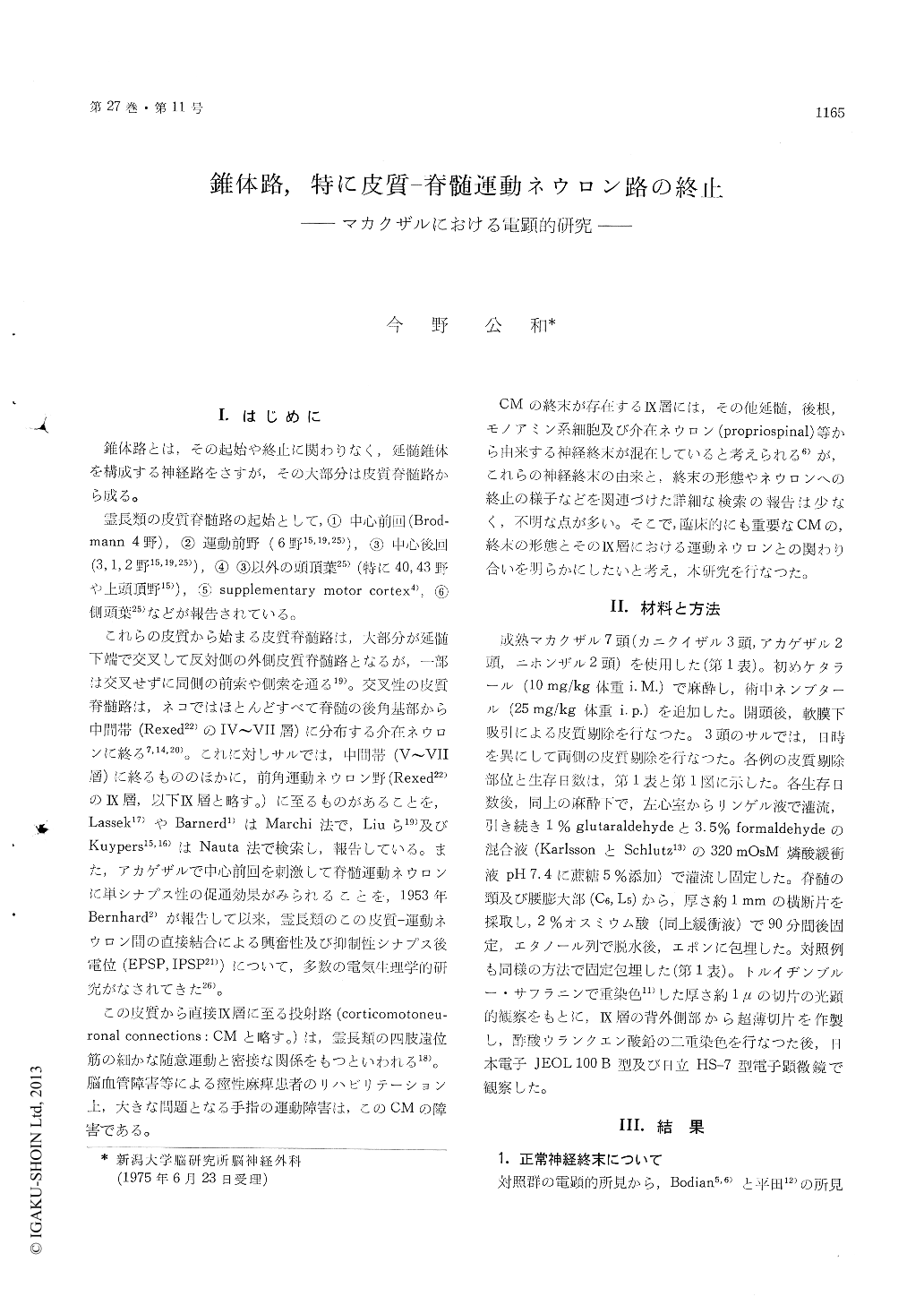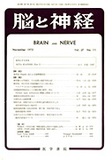Japanese
English
- 有料閲覧
- Abstract 文献概要
- 1ページ目 Look Inside
I.はじめに
錐体路とは,その起始や終止に関わりなく,延髄錐体を構成する神経路をさすが,その大部分は皮質脊髄路から成る。
霊長類の皮質脊髄路の起始として,①中心前回(Brod—mann 4野),②運動前野(6野15,19,25)),③中心後回(3,1,2野15,19,25)),④③以外の頭頂葉25)(特に40,43野や上頭頂野15)),⑤supplementary motor cortex4),⑥側頭葉25)などが報告されている。
In the present study, an attempt was made toclarify the morphological details of the terminationsof the direct cortico-motoneuronal connections (CM),which are considered to be closely related to dexter-ous movements of distal limbs.
Three adult macaque monkeys as controles andfour monkeys surviving 2 to 8 days after subpialcortical ablation of various extent were perfusedwith phosphate buffered 1% glutaraldehyde and3. 5% formaldehyde mixture. Tissue samples fromthe dorsolateral part of the motoneuronal pool(lamina IX of Rexed) contralateral to the side ofcortical ablation were taken in the cervical andlumbar enlargements of the spinal cords and pre-pared according to ordinary method for electronmicroscopy.
The terminal boutons in the normal motoneuronpool are classified into five groups according to themorphological features. Group 1 is the large boutonof 2 to 10 μ in diameter which has filamentousstructures. The synaptic vesicles are either sphericalor flattened. The boutons belonging to this groupmake synapses with proximal dendrites or moto-neuron somata which often show subsynaptic cis-terns or postsynaptic bodies and Nissl array of ERsadjacent to synaptic membranes. Some of them,in addition, are postsynaptic components (Ip) ofaxo-axonic synapses, which are supposed to be theterminals of dorsal root fibers. Group II is thesmall bouton of below 1.5 μ in diameter which hasno filamentous structure, but encloses compactlyspherical or flattened synaptic vesicles. Theseboutons make synapses not only with motoneuronsomata or proximal dendrites but also with distaldendrites. Group III is the "clustered dulb" (Bodian)consisting of several boutons which has a contactwith motoneuron somata as a presynaptic terminal.Group IV is the small bouton, though identical inmorphology of group II, which makes axo-axonicsynapses exclusively as a presynaptic component.Group V is the bouton which has cored vesiclesalone. In all the above-mentioned types of bouton,glycogen granules are rarely observed.
The two types of terminal degeneration in themotoneuron pool of spinal cords after cortical abla-tion are recognized. The first type of degenerationis characterized by the darkening of the groundsubstance and the blurring of the contour of synapticvesicles. Some of the boutons appear shrunken anddarken and lose their fine details. The second typeis an excessive accumulation of glycogen granuelseither in cluster or diffusely. Occasional groundsubstances of the boutons become darken and theirsynaptic vesicles are swollen.
These degenerated boutons of both types cor-respond well to group I excluding Ip group II andgroup IV in virtue of their morphological features.One may then conclude that the terminal boutons of CM belong to group I excluding Ip, II, and IV.
In the case of cortical ablation of some part ofoccipital, temporal, and parietal lobe sparing thepostcentral gyrus, two types of terminal degenera-tion can also be seen in the lamina IX of the spinalcord. It is surmised, therefore, that some CM mayoriginate from these cortices, although furtherstudy remains.

Copyright © 1975, Igaku-Shoin Ltd. All rights reserved.


